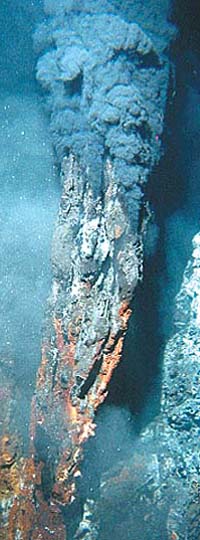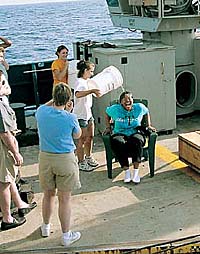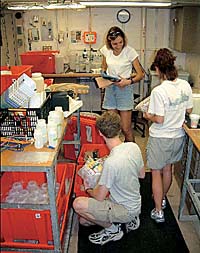 |
 |
| current issue |  |
past issues |  |
send a letter/news |  |
address update |  |
advertise |  |
about us |  |
alumni home |
Campus Currents
Going Down in Smokeby Suki Casanave '86G
 Courtesy of Karen Von Damm |
For April Hyde '05, March 22 was just another typical day in the lab. By 9 a.m., the UNH undergraduate was bubbling nitrogen into water samples retrieved from the ocean floor. In the afternoon, she prepared equipment for the next day's dive. By evening, she was relaxing on deck, watching the stars come out and ducking the occasional flying fish.
So concluded another day aboard the Research Vessel (R/V) Atlantis, a floating lab with a distinct mission: to learn more about the ocean floor between 9 and 10 degrees north latitude, known to the crew as simply "9 North." The ship's 21-member team of scientists was led by Karen Von Damm, UNH professor of chemical oceanography and an expert on deep sea hydrothermal systems. For her, this was a return to familiar research territory--along the East Pacific Rise off the coast of Mexico. For Hyde, one of four UNH students aboard, this was a brand-new experience. It was, she notes in the expedition's Web log <http://epr2004.sr.unh.edu/log.html>, an adventure she "wouldn't trade for the world."
 A crew member is welcomed back with "the bucket," a tradition for first-time divers after a day of research on the ocean floor. Courtesy of Karen Von Damm |
During their two weeks on the water, the Atlantis crew made 11 dives. Every descent took an hour and a half, the pressure increasing en route until it was 250 times greater than sea level. They went down in groups of two or three in a 23-foot-long "deep submergence vehicle," the DSV Alvin, returning each time with treasures from the deep--photographs and samples from the watery world a mile-and-a-half beneath the surface.
At the bottom, they gazed through three portholes on a fantastical dreamscape of smoking mineral chimneys. Acidic black clouds bellowed from the vents. Giant tubeworms swayed in waving masses, and temperatures reached 700 degrees Fahrenheit. The chimneys grow at a boggling eight inches per day. Bubbling monsters, they gobble up everything in their paths, including several $2,000 probes from previous expeditions.
 Chief scientist Karen Von Damm works with students aboard the R/V Atlantis. Courtesy of Karen Von Damm |
"The mid-ocean ridges are where the crust is made--it's where we're resurfacing the Earth," says Von Damm, who was awarded $650,000 from the National Science Foundation to study these ridges and will lead two more cruises there in the next five years.
"I think the place is gearing up for another volcanic eruption," says Von Damm. If she's right, UNH students on future trips will have a front row view.
Easy to print version
blog comments powered by Disqus

